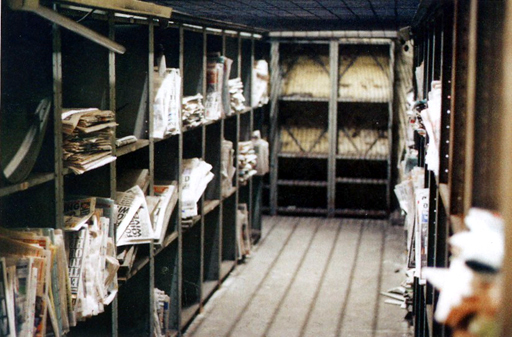Festival of Missed Fits 1962 - 2008
Gustav Metzger

Installation on Level 5 at Tate Modern, changing daily from 24–26 May 2008
Part of UBS Openings: The Long Weekend, Tate Modern
In a career which has spanned over 60 years, Gustav Metzger has employed materials including cars, newspapers and photographs to explore personal and social issues surrounding memory, history and ecology. In 1959, Metzger used political and ecological issues, such as the nuclear arms race and increasing environmental destruction, as points of departure for the development of his concept of Auto-Destructive Art.
Auto-destructive paintings, sculptures and constructions have a life time varying from a few moments to 20 years. When the disintegrative process is complete the work is to be removed from the site and scrapped.
Auto-Destructive Art Manifesto 1959, Gustav Metzger
This self-destruction may result from natural processes such as decomposition, or from techniques requiring collaboration with scientists and engineers, and may be either random or strictly controlled.
Festival of Missed Fits 1962 – 2008 is an ‘Auto-Destructive’ installation that was originally proposed as part of the Festival of Misfits, organized by members of the Fluxus group at Gallery One in 1962. Rejected by the organizers, the work remained unrealised. The proposal coincided with media coverage about the discovery of Soviet nuclear bases in Cuba and in retrospect, reveals itself as deeply reflective of society’s condition, at that time.
For The Long Weekend at Tate Modern, Metzger enacted the work as it was originally intended. Each day throughout the weekend, pages from The Daily Express were installed and de-installed, forming a graphically striking and topical collage of contemporary editorial and advertising.
In the creation of such a display Metzger posed the question of how we deal with the human catastrophes documented by media images. By emphasizing the visibility of these images, he poignantly revealed the tensions they provoke between voyeurism, trivialization, and sympathy.
Metzger has been constantly and profoundly aware of technology’s role in the mass destruction of war and the world’s ecology and often overtly critical of technological utopianism. In the early years of his practice however, Metzger was probably the artist who worked most consistently with an approach to technology that was distinctly critical while still engaging with its processes. Chemicals, factory machinery and computers were all aspects of technology that Metzger explored in his work throughout the 1960s and 1970s. His Auto-Destructive Art projects have been realised as manifestos, lectures, public actions, environmental sculptures and installations that invite public intervention. In fact many of Metzger’s projects have remained unrealised and exist only as proposals and models.
In more recent work, Metzger provokes further examination of the way in which history is defined and translated through the media, using enlarged press images of catastrophic events which are directly linked to Metzger’s experience as a Holocaust survivor.The images are intentionally obscured or cloaked and presented in awkward-to-view configurations, with obstacles prohibiting the usual fleeting consumption of mass-media imagery. Viewers are expected to participate in the works by physically climbing under, or passing behind, materials and objects and to perform acts that mirror those documented in the photographs.
Many of Metzger’s works consciously resist commoditisation by the art market by being public, performative and temporal. Situated between performance and the object, his work is an examination of the complex relationships linking dematerialisation processes, action or performance, and works of art. The projects are often concerned with acts of transformation as well as the possibilities and implications of utilising time and process as integral elements within an artwork.
Biography
Further References
Auto-Destructive Art ManifestosRead Gustav Metzger’s Auto- Destructive Art Manifestos 1959-61
